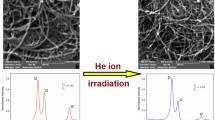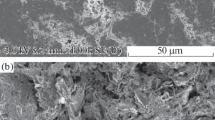A theoretical study of the radiation stability of carbon nanostructures irradiated by an electron beam has been made. Calculations have been performed with the use of an analytical expression for the cross-section for scattering of relativistic electrons by carbon atoms, as well as of the data on the threshold energy of atomic displacement from the carbon lattice obtained by the molecular dynamics method. Stability limits of carbon nanostructures and basic parameters of the process have been found. The calculated values of the characteristic time of the process are in good agreement with the available experimental data.
Similar content being viewed by others
References
I. P. Suzdalev, Nanotechnology: Physics and Chemistry of Nanoclusters, Nanostructures, and Nanomaterials [in Russian], KomKniga, Moscow (2006).
B. Brushan (Ed.), Springer Handbook of Nanotechnology, Springer, Berlin (2007).
M. P. Anantram and F. Leonard, Physics of carbon nanotube electronic devices, Rep. Prog. Phys., 69, No. 3, 507–561 (2006).
Y.-W. Son, M. L. Cohen, and S. G. Louie, Half-metallic graphene nanoribbons, Nature, 444, No. 7117, 347–349 (2006).
C. Wang, Z.-X. Guo, S. Fu, W. Wu, and D. Zhu, Polymers containing fullerene or carbon nanotube structures, Prog. Polym. Sci., 29, No. 11, 1079–1141 (2004).
S. V. Ahir, Y. Y. Huang, and E. M. Terentjev, Polymers with aligned carbon nanotubes: active composite materials, Polymer, 49, No. 18, 3841–3854 (2007).
Y. Hu, O. A. Shenderova, Z. Hu, C. W. Padgett, and D. W. Brenner, Carbon nanostructures for advanced composites, Rep. Prog. Phys., 69, No. 6, 1847–1895 (2006).
T. Ramanathan, A. A. Abdala, S. Stankovich, et al., Functionalized graphene sheets for polymer nanocomposites, Nature Nanotech., 3, No. 6, 327–331 (2008).
M. Hirscher and M. Becher, Hydrogen storage in carbon nanotubes, J. Nanosci. Nanotech., 3, No. 1, 3–17 (2003).
M. Shim, N. W. S. Kam, Y. Chen, et al., Functionalization of carbon nanotubes for biocompatibility and biomolecular recognition, Nanoletters, 2, No. 4, 285–288 (2002).
V. M. Biryukov, S. Bellucci, and V. Guidi, Channeling technique to make nanoscale ion beams, Nucl. Instr. Meth., B231, Nos. 1–4, 70–75 (2005).
N. I. Alekseyev and G. A. Dyuzhev, Fullerene formation in an arc discharge, Carbon, 41, No. 7, 1343–1348 (2003).
D. Kasuya, F. Kokai, K. Takahashi, M. Yudasaka, and S. Iijima, Formation of C60 using CO2 laser vaporization of graphite at room temperature, Chem. Phys. Lett., 337, Nos. 1–3, 25–30 (2001).
S. Musso, S. Porro, M. Rovere, M. Giorcelli, and A. Tagliaferro, Fluid dynamic analysis of gas flow in a thermal-CVD system designed for growth of carbon nanotubes, J. Cryst. Growth, 310, No. 2, 477–483 (2007).
M. I. Katsnelson, Graphene: carbon in two dimensions, Mater. Today, 10, Nos. 1–2, 20–27 (2007).
K. S. Novoselov, A. K. Geim, S. V. Morosov, et al., Electric field effect in atomically thin carbon films, Science, 306 No. 5696, 666–669 (2004).
R. Van Noorden, Moving towards a graphene world, Nature, 442, No. 7100, 228–229 (2006).
A. G. Chmielewski, D. K. Chmielewska, J. Michalik, and M. H. Sampa, Prospects and challenges in application of gamma, electron and ion beams in processing of nanomaterials, Nucl. Instrum. Meth., B265, No. 1, 339–346 (2007).
A. V. Krasheninnikiv and K. Nordlund, Irradiation effects in carbon nanotubes, Nucl. Instrum. Meth., B216, No. 1, 335–366 (2004).
K. H. An, K. A. Park, J. G. Heo, et al., Structural transformation of fluorinated carbon nanotubes induced by in situ electron-beam irradiation, J. Am. Chem. Soc., 125, No. 10, 3057–3061 (2003).
J. Onoe, T. Nakayama, M. Aono, and T. Hara, The electron transport properties of photo- and electron-beamirradiated C60 films, J. Phys. Chem. Solids, 65, Nos. 2–3, 343–348 (2004).
A. Hashimoto, H. Terasaki, A. Yamamoto, and S. Tanaka, Electron beam irradiation effect for solid C60 epitaxy on graphene, Diamond Relat. Mater., 18, Nos. 2–3, 388–391 (2009).
D. M. Guldi, Radiation chemistry of fullerenes, Stud. Phys. Theor. Chem., 87, No. 1, 253–286 (2001).
F. Banhart, Irradiation effects in carbon nanostructures, Rep. Prog. Phys., 62, No. 8, 1181–1221 (1999).
M. R. C. Hunt, J. Schmidt, and R. E. Palmer, Electron-beam-induced fragmentation in ultrathin C60 films on Si (100)-2 x 1-H: Mechanisms of cage destruction, Phys. Rev., B60, No. 8, 5927–5937 (1999).
G. S. Was and T. R. Allen, Radiation damage from different particle types, in: (K. E. Sickafus, E. A. Kotomin, and B. P. Uberuaga Eds.), Radiation Effects in Solids, Springer, Dordrecht (2007), pp. 65–98.
L.-C. Qin, Electron diffraction from carbon nanotubes, Rep. Prog. Phys., 69, No. 10, 2761–2821 (2006).
B. W. Smith and D. E. Luzzi, Electron irradiation effects in single wall carbon nanotubes, J. Appl. Phys., 90, No. 7, 3509–3515 (2001).
M. Hohenstein, A. Seeger, and W. Sigle, The anisotropy and temperature dependence of the threshold for radiation damage in gold–comparison with other FCC metals, J. Nucl. Mater., 169, No. 1, 33–46 (1989).
F. Z. Cui, H. D. Li, and X. Y. Huang, Atomistic simulation of radiation damage to C60, Phys. Rev., B49, No. 14, 9962–9965 (1994).
V. H. Crespi, N. G. Chopra, M. L. Cohen, A. Zettl, and S. G. Louie, Anisotropic electron-beam damage and the collapse of carbon nanotubes, Phys. Rev., B54, No. 8, 5927–5931 (1996).
M. V. Makarets, Yu. I. Prylutskyy, O. V. Ogloblya, L. Carta-Abelmann, and P. Scharff, Computer simulation of supported C60 fullerenes fragmentation by particle beam, Carbon, 42, Nos. 5–6, 987–990 (2004).
W. A. McKinley, Jr. and H. Feshbach, The Coulomb scattering of relativistic electrons by nuclei, Phys. Rev., 74, No. 12, 1759–1763 (1948).
Author information
Authors and Affiliations
Corresponding author
Additional information
Translated from Inzhenerno-Fizicheskii Zhurnal, Vol. 83, No. 2, pp. 369–375, March–April, 2010.
Rights and permissions
About this article
Cite this article
Gerasimov, G.Y. Radiation stability of carbon nanostructures. J Eng Phys Thermophy 83, 393–400 (2010). https://doi.org/10.1007/s10891-010-0356-9
Received:
Published:
Issue Date:
DOI: https://doi.org/10.1007/s10891-010-0356-9




